

Lectures in Medieval History. Dictionary and Thesaurus We have already noted that one of the factors leading to the disintegration of the Carolingian empire was that its failure to expand turned the energies of its land-hungry class of fighting land-holders inward.
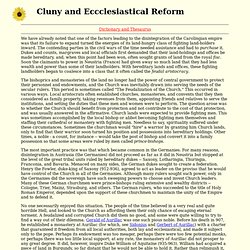
The contending parties in the civil wars of the time needed assistance and had to purchase it. Dukes and counts, margraves and local officials first demanded that their land-holdings and offices be made hereditary, and, when this point had been won, often sought grants of land from the royal fisc. Soon the claimants to power in Neustria (France) had given away so much land that they had less wealth and power than some of their landholders. With hereditary lands and offices, these fighting landholders began to coalesce into a class that it often called the feudal aristocracy. The most important practice was that which became common in the Germanies. No one necessarily enjoyed this situation. Europe in 910. Abbaye de Cluny.
Un article de Wikipédia, l'encyclopédie libre.

Study 2, Fernando I and the origins of the Leonese-Castilian Alliance with Cluny. Universität Münster > Institut für Frühmittelalterforschung - Projekt Cluny. From Rotulus to data bank The evangeliarium of Helmarshausen (circa 1120-1140), slightly modernized Nearly 70,000 names of persons mentioned in the edition (ed. by Bernard and Bruel) of the 5,500 charters of the monastery of Cluny (10th - 13th century) are now available in a data base with further informations concerning their offices, their activities, and their parental relationship.
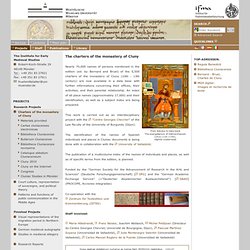
An index of all place names (approximately 17,000) and their identification, as well as a subject index are being prepared. This work is carried out as an interdisciplinary project with the "Centre Georges Chevrier" of the Law Faculty of the University of Burgundy (Dijon). The identification of the names of Spanish individuals and places in Cluniac documents is being done with in collaboration with the University of Valladolid. The publication of a multivolume index of the names of individuals and places, as well as of specific terms from the edition, is planned. Staff involved: St. Odo of Cluny - St. Odon of Cluny - November 18 - Plinio Correa de Oliveira commentary on the Saint of the Day @ TraditionInAction.org. Biographical selection: Odo (879-942) was son of noble parents who lived in the Alsace, France.
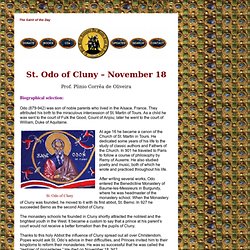
They attributed his birth to the miraculous intercession of St. Martin of Tours. As a child he was sent to the court of Fulk the Good, Count of Anjou; later he went to the court of William, Duke of Aquitaine. Universität Münster > Institut für Frühmittelalterforschung - Projekt Cluny. Les ateliers Retour en haut de page Les sources Les manuscrits Les travaux L'hagiographie Dictionnaire clunisien Textes on Cluniac History presented by the Catholic Encyclopedia:
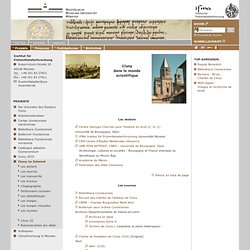
Fédération des Sites Clunisiens - Le réseau des Sites clunisiens, Grand Itinéraire culturel du Conseil de l'Europe. Odon de Cluny (vers 879-942). Itinéraire et ecclésiologie d’un abbé réformateur, entre aristocratie carolingienne et monde féodal. 1Mener une étude sur Odon, deuxième abbé de Cluny, se justifiait par trois exigences historiographiques.
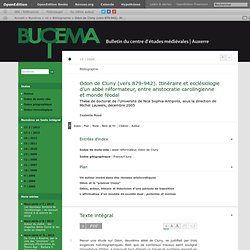
Bien que de nombreux travaux aient souligné l’importance d’Odon, il manquait tout d’abord un travail de synthèse prenant en compte l’ensemble de ses œuvres et son activité réformatrice 1. Par ailleurs, alors que plusieurs études avaient éclairé l’histoire de Cluny à son apogée, mais également le « Cluny d’après Cluny », les débuts du monastère demeuraient relativement mal connus 2. Dans ce cadre, en tenant compte des apports épistémologiques formulés depuis une vingtaine d’années, l’utilisation du biais biographique permettait, grâce à un dossier documentaire exceptionnellement riche, de réunir ces différentes approches 3. Plus encore, dans le cas d’Odon, grand aristocrate, intellectuel de haut niveau et multi-abbé de grande ampleur, l’approche biographique permettait, en dernier lieu, d’appréhender une période mal connue, la fin du ixe et la première moitié du xe siècle. Cluniac Order. The order of Cluny is a Benedictine offshoot founded at a time when reformist ideas were gaining momentum within the Church.
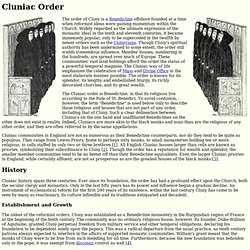
Widely regarded as the ultimate expression of the monastic ideal in the tenth and eleventh centuries, it became immensely popular, only to be superceded in the twelfth by newer orders such as the Cistercians. Though Cluny's spiritual authority has been undermined to some extent, the order still wields tremendous influence. Member houses, numbering in the hundreds, are spread over much of Europe. These communities' vast land holdings afford the order the status of a powerful temporal magnate.
Fêtes à Cluny pour le toilettage de l’abbaye. Chronique culture 12 août 16/10/2013 - par Ariane Kujawski écouter Quand on marche dans Cluny, un jour comme un autre, sans festivités, sans foule dans la rue, on est frappé par l’ambiance de paix qui se dégage du bourg.

Le décor, les bâtiments datant de l’époque médiévale, donnent l’impression de baigner dans cette spiritualité qui a fait la notoriété de Cluny. Car si cette ville bourguignonne peut sembler endormie, elle a été, au Moyen Age, un lieu d’effervescence chrétienne. Des centaines d’années plus tard, on peut ressentir une atmosphère à part, qu’on l’appelle recueillement, méditation, ou prière. De ce passé religieux et moyenâgeux, il ne reste que des bâtiments construits plus tardivement, notamment l’abbatiale Cluny III. L’Etat et la commune ont finalement décidé en 2007 de réhabiliter l’ensemble pour le valoriser. CLUNY.
Abbaye Cluny. ORB: The Online Reference Book for Medieval Studies. LE JURA CÉLÈBRE CLUNY. Letter from France: A time tunnel named Cluny. Cluny and other monastic movements of the Central Middle Ages. Discover Cluny: Photos and hotspots on Google Maps, no need to book a flight or hotel. Communauté Google à Cluny. Cluny – Famous Benedictine Abbey. The history of monasticism is one of alternate periods of decay and revival.
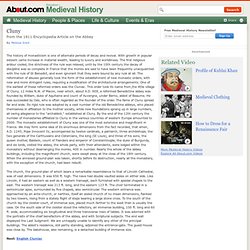
With growth in popular esteem came increase in material wealth, leading to luxury and worldliness. Ordre de Cluny. St. Odo of Cluny. Art et Architecture Romane, par. Abbaye de Cluny - Centre des monuments nationaux. The Early Abbots of Cluny. The monastery of Cluny (in France, northwest of Lyons) was a center for the reform and spiritual renewal of Western monasticism in the tenth and eleventh centuries.

It was founded in 909 under Abbot Berno, as a reformed monastery, observing the Benedictine Rule with a strictness unusual at the time. Many monasteries in Europe at that time were dominated by a nearby king or nobleman. It was intended that Cluny should be independent of all but papal jurisdiction. Its second abbot was Odo (born 879 at Tours, monk in 909, abbot in 927, died 18 November 942--one of my sources says 944). He obtained papal and royal charters which guaranteed the monastery freedom from outside interference. The third abbot was Aylward, who held office from 942 to 965. Mayeul (or Maieul or Maiolus) was born at Avignon around 906, became a clergyman, was made archdeacon of Macon, and fled to Cluny in order to avoid being made bishop of Besancon.
PRAYER (traditional language): PRAYER (contemporary language): Abbaye de Cluny. Cluny Abbey. Cluny Abbey - Cluny, France. Site of the former Cluny Abbey church (1088-1130), of which only the south transept survives, seen from the west in some dramatic evening light. The semicircular area in the foreground is the… View all images in our Cluny Abbey Photo Gallery. Site of the former Cluny Abbey church (1088-1130), of which only the south transept survives, seen from the west. The area in the parvis (an outdoor staircase). This led down to the huge antechurch or… Painting of Cluny Abbey before it was mostly destroyed. 18th-century monumental cloister built on the site of the original Romanesque cloister.
Congregation of Cluny. Cluny. Foundation Charter of Cluny, 910. From the tenth century there were successive waves of monastic reform - Cluniac, Cistercian, Mendicant and so forth. The founding of the abbey of Cluny in 910 marked the onset of this period. As well as providing some basis for Cluny's later power and independence, the charter is an example of why donations were made to the Church. It ends with some truly magnificent curses. To all right thinkers it is clear that the providence of God has so provided for certain rich men that, by means of their transitory possessions, if they use them well, they may be able to merit everlasting rewards. Cluny 2010 - construire une harmonie. Cluny. Abbaye de Cluny (Saône-et-Loire)
Cluny numérique. Abbey of Cluny (Burgundy)